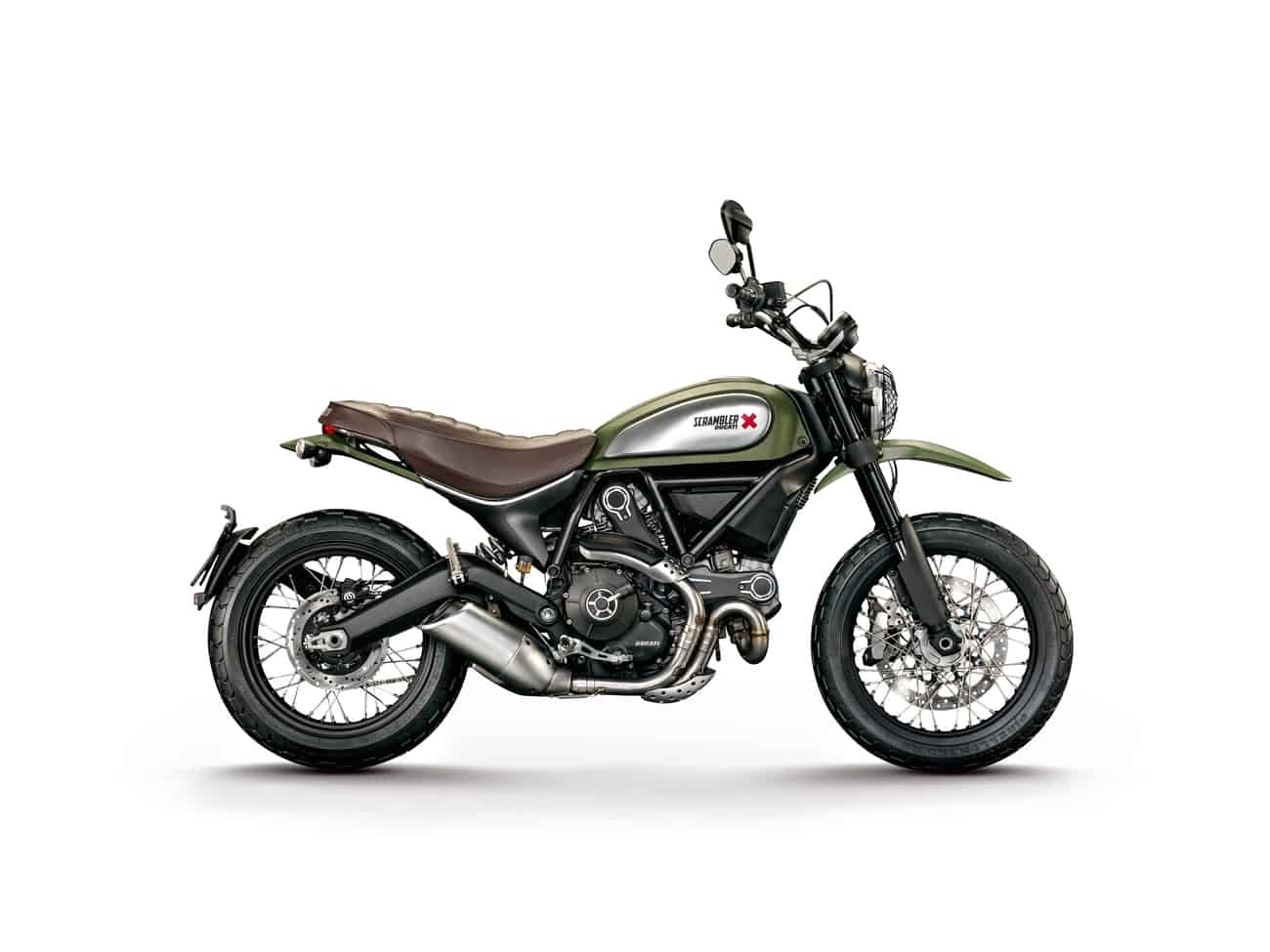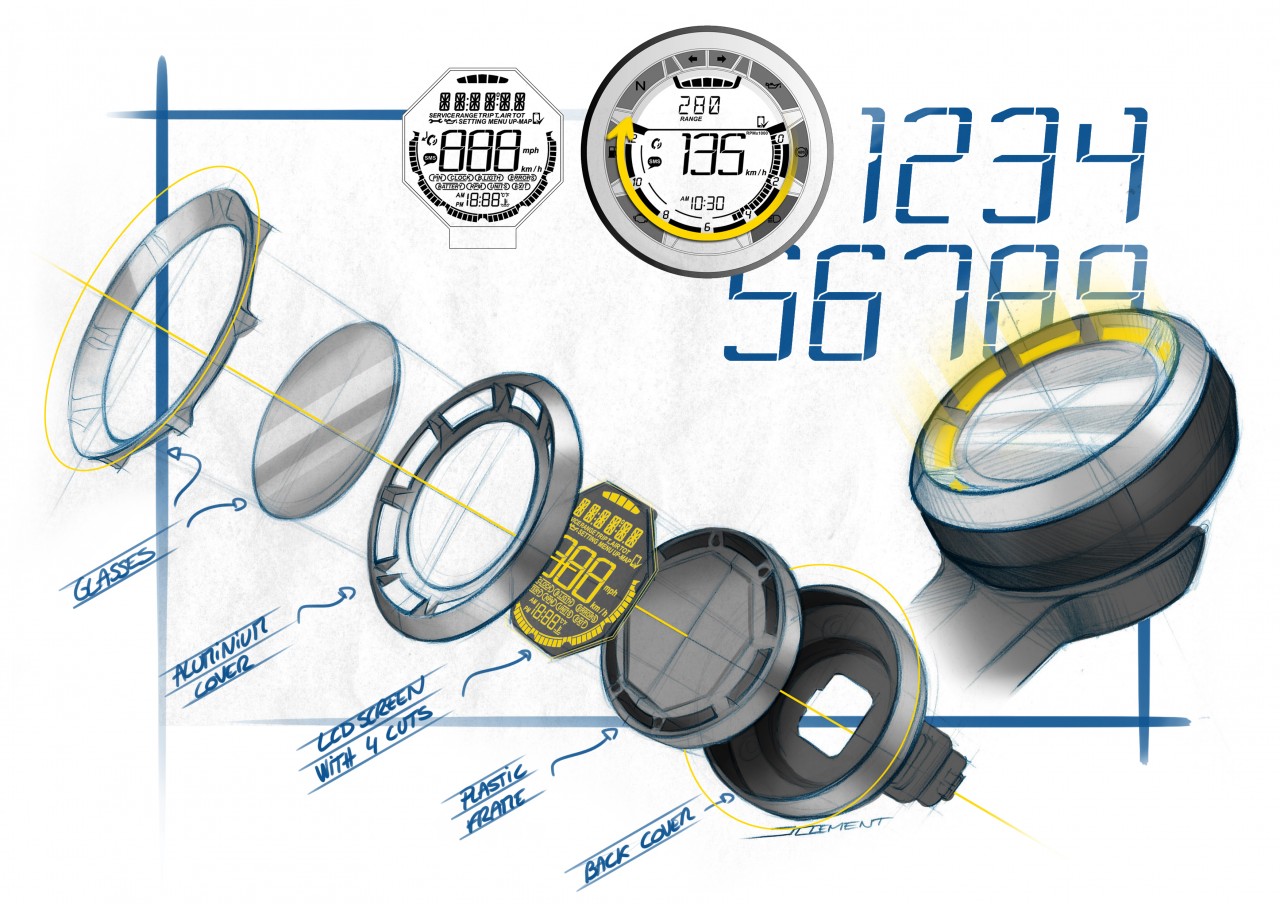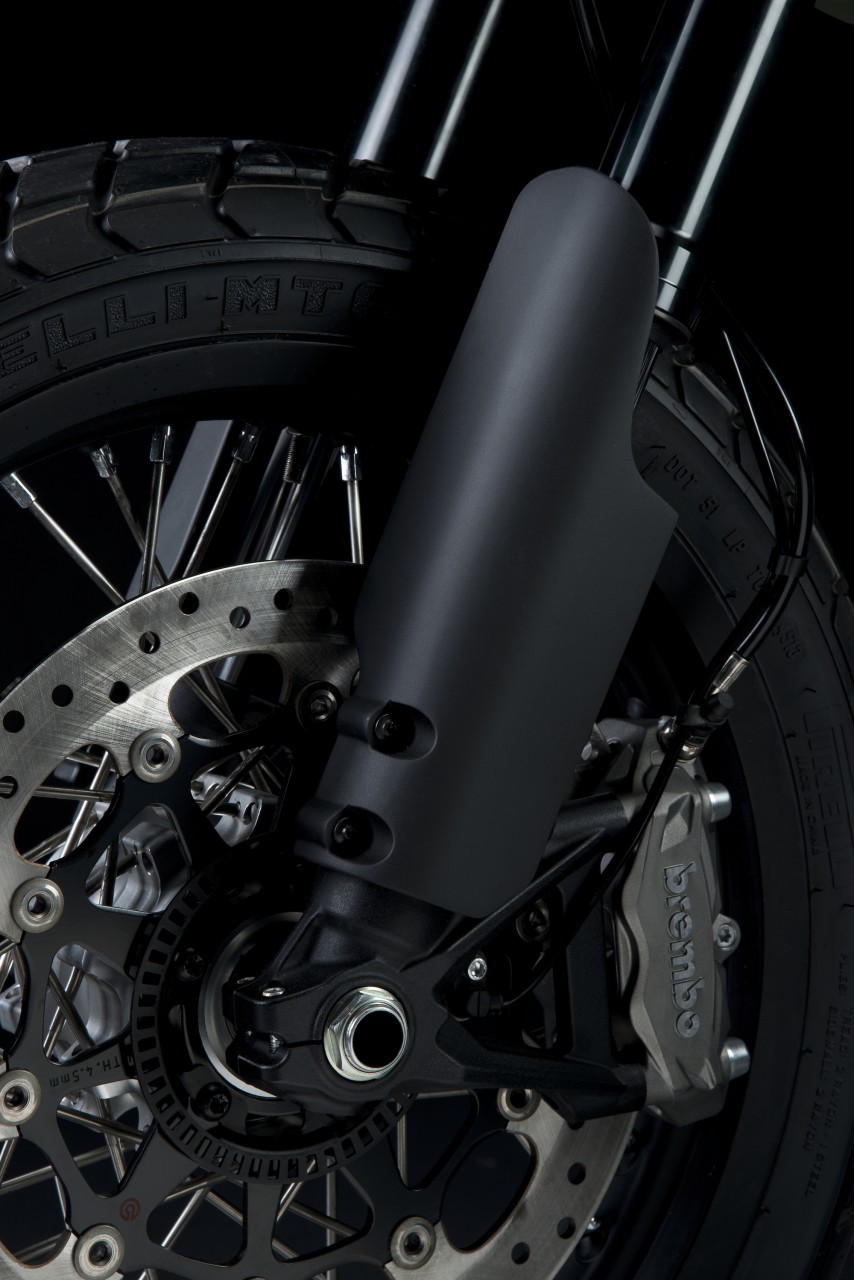“Fortune Favors the Bold”, the phrase bellowed from the lungs of Turnus as he charged against the Aeneas‘ Trojans in Virgil’s Aeneid. The Italians are lauded throughout history for their brave and bold actions, and the resulting fortunes that come from those risks. As a brand, Ducati has always favored the bold, and released lustful objects since the 1950s, but the truly exceptional Ducati motorcycles started with the Mach 1, and from our perspective, have reached a pinnacle of desire with the 2015 Scrambler. The Ducati Scrambler was launched today at INTERMOT, to voracious praise.

Even the most ardent adventure rider can appreciate the beautiful and fast motorcycles produced in Bologna, Italy, but few have really addressed our need for stunning design and dirt performance. Sure, the Multistrada has been available for many years, but it is really a compromise in both arenas. However, Ducati has just announced the Scrambler, a beautiful motorcycle that is begging, no, screaming for a set of TKC80s and a long drift around a monstrous gravel sweeper. At Overland Journal and Expedition Portal, we certainly acknowledge the technical nature of machines, but we love something interesting. The Ducati Scrambler is not just interesting, but truly captivating. . . Look for some images and notes from the field, as soon as we can grab the keys and wipe the smile off our dusty faces.
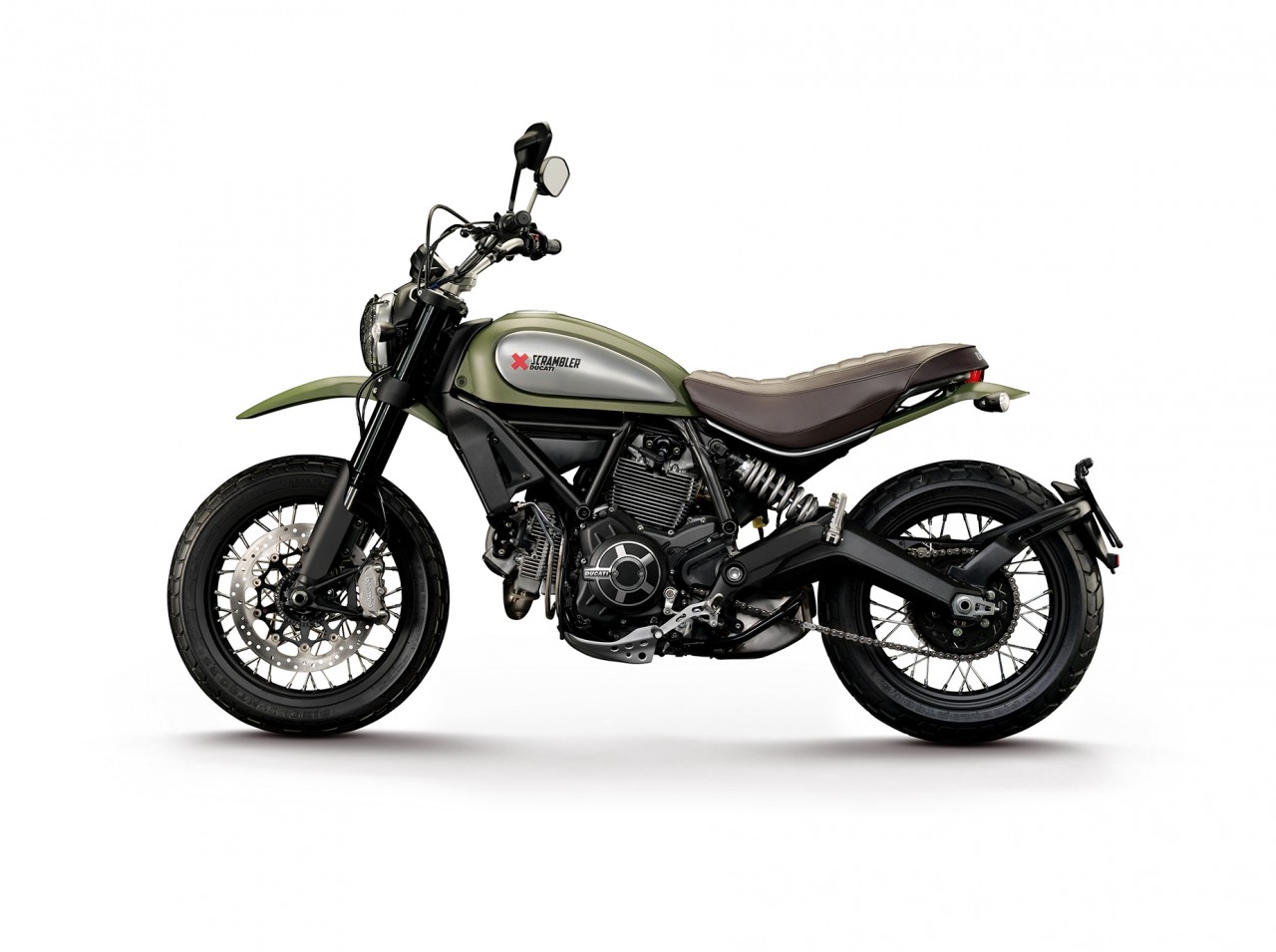
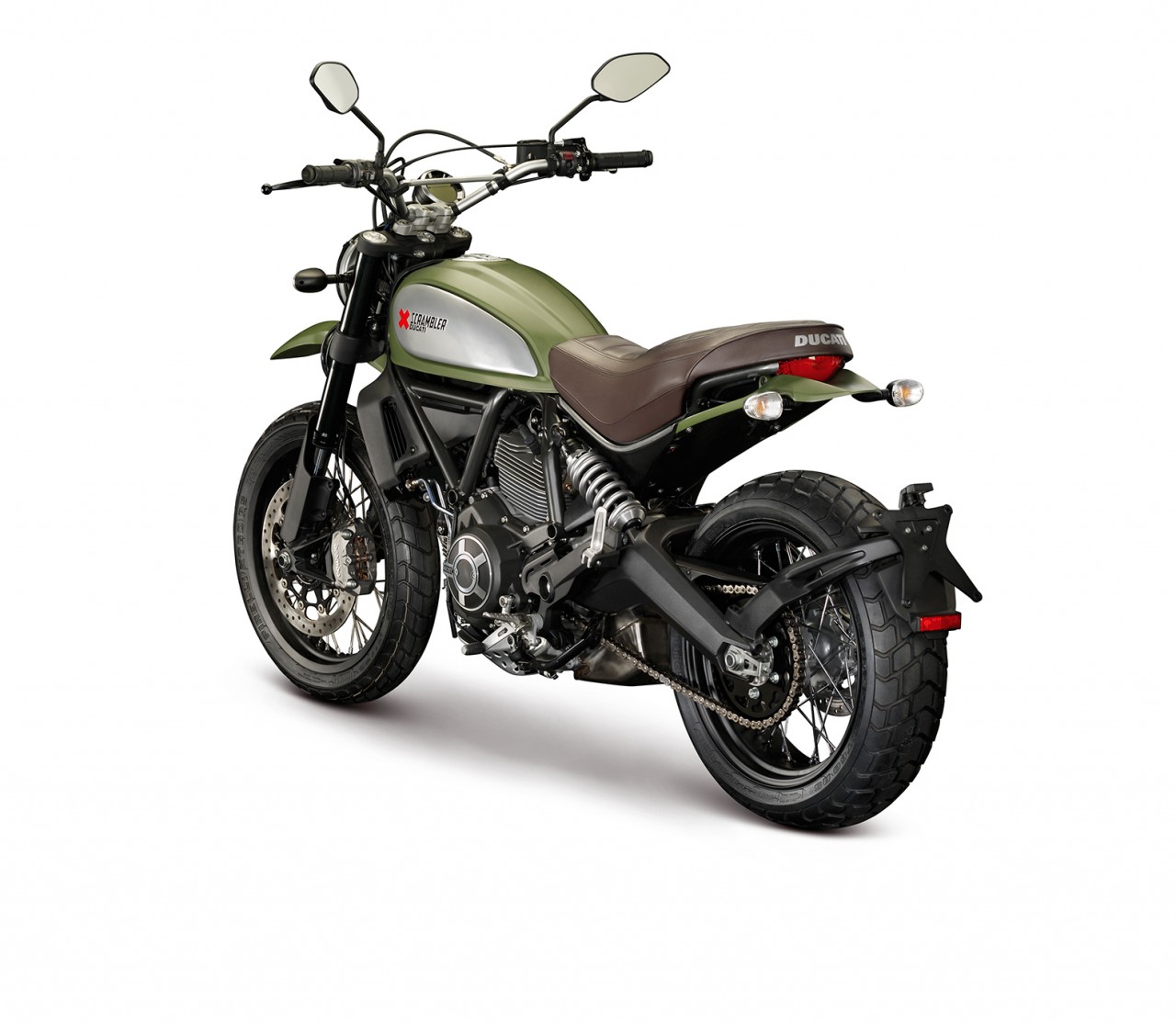
Overview of Scrambler models and features
Scrambler Urban Enduro
Colour
1. “Wild Green” with black frame and brown seat
Features
o Spoked aluminium wheels
o Engine sump guard
o High front mudguard in plastic fibre
o Headlight grill
o Handlebar cross-strut
o Plastic fibre fork protectors
o Dedicated seat with horizontally ribbed stitching pattern
A new world
Ducati Scrambler offers groundbreaking style and substance. Anti-conformist, accessible and essential, the Ducati Scrambler is a perfect mix of tradition and modernity, a stride towards the pure essence of motorcycling: two wheels, wide handlebars, a straightforward engine and endless fun. The Scrambler world – the latest addition to the Ducati universe – is one of authentic creativity and free expression; the lead-up to its official arrival has generated an unprecedented buzz, as has a captivating launch campaign of outstanding originality.
First, Ducati wanted to share the arrival of the Scrambler with the employees who constitute the very heart of the company. On 9 June they got an exclusive preview when the factory entranceway was transformed into a beach with music, longboards, street food and a huge yellow container: a surprise event that Ducati had set aside for the inner community of production line/office workers and managers at the Borgo Panigale plant to get them thoroughly involved in the new project and treat them to a very private look at the prototype.
From 18 to 20 July, fans flocking to World Ducati Week 2014 were able to enjoy a similar peek at the new Scrambler. An island-like “Land of Joy” area was set up in the Marco Simoncelli Misano World Circuit paddock area, perfectly showcasing just what the Scrambler is all about. Needless to say, the centrepiece was the famous yellow container.
Snippets of info on the look and content of the Scrambler were also released on the internet in a 3-episode web series made using stop-motion animation (the leading characters were handmade plasticine models painstakingly made by three talented 19-year-olds from Bologna). The series tells the imaginative story of how the Ducati Scrambler ended up in the present day; the main characters were, in addition to the Scrambler itself, Franco and Elvira, the former Ducati employees who headed the original Scrambler advertising campaign in the ’70s: at the time he was working at Ducati as a test rider and she – easily as beautiful as any professional model – was working in administration.
The Ducati Scrambler campaign has also launched the internet-based Scrambler You Are competition, open to all video makers eager to show off their style and skill. Their challenge is to come up with a short video illustrating the thrills and experiences typical of the Scrambler world. The competition closes on 20 October, when a jury of experts will reveal the winners and assign the €8000 prize money. Scrambler You Are highlights, more than ever, just how much the Scrambler is a free-spirited, creative bike that belongs to everyone… because there’s an avid Scrambler fan inside every motorcyclist.
Post-heritage design
When the Ducati Design Center started working on the Scrambler the goal immediately became a very clear one: to revive a legend while, simultaneously, building a truly modern bike. A new bike inspired by the iconic ’70s model but with all the technical specifications of a present-day one. That’s why, for example, the bike features an upside down stanchion fork, alloy rims, a rear monoshock, and front radial-mount calipers.
Everything on the Ducati Scrambler has been designed to be as “Ducati” as possible while remaining faithful to the style of its inspiring predecessor. Firstly, there’s the tank, sculptural and lovingly shaped yet loyal to the original teardrop design of the ‘70s model, including the ‘upward sloping’ look. Additional character is provided by the tank side covers: made of brushed aluminium, they’re interchangeable to allow plenty of scope for personalisation and feature version-specific logos.
Seat and tank have been formed carefully to give the Ducati Scrambler eye-pleasing proportions. A compact bike, the Scrambler instils confidence from the moment you set eyes on it. It’s been sized to make it accessible to all motorcyclists while its long seat maximises comfort and can accommodate a passenger comfortably, because the Ducati Scrambler is all about sharing too.
A great deal of thought has gone into every detail on the Scrambler, including the ultra-modern rear swingarm and the exhaust pipe routing, a layout that echoes the look seen on the latest Ducati nakeds. The short silencer and the rear mudguard tip have been designed to make the bike more compact, as have the passenger grab handles, hidden by the openings on the upper part of the seat.
Redesigned for the present day, the round headlamp is a key part of the Scrambler look. Ultra-modern LED light guide technology (used for the side lights) underlines the outstanding level of technical expertise. The filler cap, which sports the inscription “born in 1962”, reflects the closure system in vogue in the ‘70s; similarly, the key, once inserted in the switchgear on the headlamp unit, recalls the design of the original light switch. Under-seat moulding provides another ‘70s design throwback.
Innovative front headlamp
Together with the fuel tank, the front headlamp is one of the most characteristic features of the Ducati Scrambler. Round, classically designed yet contemporary – that is, post-heritage – it has a glass front with a modern, LED-powered light guide around the rim (this acts as a side light). When on, it recalls the popular ‘70s stratagem of applying protective adhesive tape to off-road bike headlights. The high-beam function is performed by a single bulb hidden behind a Ducati-logoed screen. Moreover, the contrast between the cold white side light and warm yellow headlamp gives the Ducati Scrambler yet another personality boost.
At the rear, instead, lies a full-LED unit. This gives off a suffused light and features a technology unprecedented on motorcycles; this ‘soft’ effect is, in fact, achieved by combining an opaque light-diffusing lens with a 12-LED electrical card (18 LEDs when the brake is applied).
The bulb-powered indicators – positioned to the sides of the headlamp and on the rear mudguard – match the Scrambler style to perfection. Ducati Scrambler riders are also provided with a hazard light function, activated simply by holding down the left indicator button for three seconds.
Instruments
The Scrambler instrument panel consists of a single, round unit positioned above and slightly to the right of the headlamp. Fully digital, it has an engine rpm scale resonant of those seen on ‘70s motorcycle speedometers (i.e. in the lower part of the instrument body). As engine revs increase the digits light up clockwise (right to left). Ducati Scrambler instrumentation also features two trip odometers and one total- mileage odometer, a trip fuel indicator, an air temperature display, maintenance reminders, a clock, and fuel reserve and ABS warning lights. Riders can also count on an engine oil pressure warning light, high beam indicator, neutral indicator, turn signal indicators, immobilizer and over-rev warning light.
Controls
Post-heritage styling is also evident on Ducati Scrambler controls. The wide handlebars house a classic wire-connected twist-grip throttle together with an axial-pump front brake lever with 4 different position settings. Minimalist Scrambler design continues with the cable-actuating clutch lever. The switchgear is characterised by the now-standard yet exclusive “trigger catch” that slides down to cover the starter button when the kill switch is activated. It’s the same one used on all Ducati bikes, its high tech design underscoring the post-heritage style of the Scrambler.
The black painted die cast aluminium footrest plates support the gear change lever and the off-road type rear brake lever.
Engine
An oil cooled L-twin two-valve 803 cc engine powers the Ducati Scrambler. Derived from the Monster 796 engine, it has an 88 mm bore, a 66 mm stroke and has been redesigned to give smooth acceleration throughout the rev range. The Desmodue engine on the Scrambler has light machine-finished aluminium covers, including those on the clutch and alternator. The two belt covers are also made of aluminium and have, likewise, been machine-finished to enhance aesthetics.
To ensure smooth integration with the compact steel teardrop tank, the Desmodue engine on the Scrambler features a single Ø 50 mm throttle body with two sub-butterfly injectors: this solution ensures fluid power delivery and accurate control of the fuel being aspirated into the cylinders.
Pistons and crankshaft are the same as those on the Monster 796 and Hypermotard 796 power units, while the camshafts have been designed to ensure linear power delivery thanks to the adoption of an 11° valve overlap angle. The 2-in-1 exhaust with aluminium silencer has been specially designed for the Scrambler. It features an aluminium heat plate for improved rider protection and is EURO 3 compliant.
The gearbox is a 6-speed unit while the multiplate APTC oil bath clutch with cable actuation, while emphasising the minimalist nature of the Scrambler, provides a light-touch brake lever with outstanding ‘feel’, a real plus point when it comes to the continuous stop-and-go of inner city traffic. Moreover, it features a torque-linked anti-hopping system that prevents rear wheel chatter when downshifting.
The twin-cylinder Desmodue engine on the Scrambler has been designed to favour smooth running and fluid acceleration throughout the rev range, putting out 75 hp (55.2 kW) @ 8,250 rpm and 50.2 lb-ft (6.9 kgm) of torque @ 5,750 rpm. Just like the Scrambler itself, it is designed to be simple and accessible and also features generous 12,000 kilometres maintenance intervals.
Desmo delight
The Scrambler is iconic, as is the celebrated Ducati Desmo, the engine valve closure system that has made Ducati famous all over the world. This system opens and closes the intake and exhaust valves positively and precisely, using a system of cams and levers. The term desmodromic stems from the Greek words desmos (link) and dromos (stroke); mechanically speaking, the term refers to mechanisms with a control to operate them in one direction (e.g. opening) and another which acts in the opposite direction (closure or return).
However, the desmodromic concept is not a recent one and has been used in the motorcycle and car industries for some time. It first appeared, in a variety of forms, way back at the start of the twentieth century. In 1956 renowned engineer Fabio Taglioni set Ducati off along the desmodromic path: the first bike to feature the solution was the Grand Prix 125, which had three overhead camshafts, driven by a vertical shaft and a bevel gear.
From that point on desmodromic history became a Ducati exclusive and in 1968 the company started producing this timing system as standard with the Mark 3 Desmo 350. This milestone of a motorcycle essentially had the same timing system as current 2-valve twin cylinder engines like the one on the Scrambler, clear evidence of the concept’s soundness. Used on all Ducati models, the system is also employed on Ducati Corse’s Superbikes and Desmosedici MotoGP bikes.
The frame
The Ducati Scrambler features a twin upper spar steel Trellis frame. Essential and elegant, the Scrambler frame embraces the engine and extends beneath the seat, providing the stiffness one expects from a real Ducati. Thanks to a steering head angle of 24° and a 112 mm offset on the fork yokes, manoeuvrability is outstanding both in city traffic and on Alpine hairpins. Thanks to the wide handlebars, weaving your way through the urban obstacle course on a Scrambler is child’s play, while the 1445 mm wheelbase maximises stability at high speeds. The steel fuel tank, with that unmistakeable teardrop contour, has a capacity of 13.5 l (3.6 US gal). With an excellent frame and outstanding chassis geometry, the Scrambler makes for relaxed riding that is easy yet fun. User-friendly and agile, the Ducati Scrambler is a source of endless satisfaction on both city streets and the open road.
Suspension
The Kayaba suspension system on the Ducati Scrambler makes use of a 41 mm upside down stanchion fork and a monoshock with adjustable spring preload. Both provide 150 mm of wheel travel, ensuring the tyres hug the ground whatever the terrain, from city streets to undemanding off-road routes. It is this mix of comfort and performance that makes the Ducati Scrambler unique, letting riders express themselves to the maximum everywhere and anywhere.
Wheels and tyres
All new aluminium 10-spoke wheels – of evident flat-track origin – come as standard on the Ducati Scrambler. The design is a throwback to the days of thin, criss-crossed spokes inserted in the hub. The 3’’ x 18’’ front rim and the rear 5.5 x 17 one have been designed to be light and mount the new enduro-type Pirelli MT60 RS 110/80 ZR18 tyre at the front and the 180/55 ZR17 at the rear; featuring a chunky tread pattern, these tyres are produced exclusively for the Scrambler. The result is outstanding performance on surfaces of any kind.
Brembo braking system with 2-channel ABS
The Ducati Scrambler features Brembo braking using the Bosch 9.1 MP AMS system with an internal pressure sensor. To combine maximum stopping performance with minimalist styling the front wheel has a single Ø 330 mm disc, no less than 5 mm thick, with a 4-piston Brembo M 4.32B monobloc radial-mount caliper. This heavy duty single-disc front brake solution was chosen to leave a clear view of the wheel design on the right. At the back, instead, a Ø 245 mm disc is gripped by a caliper with a Ø 32 mm piston.
Self expression
Ducati Scrambler is self expression and the Urban Enduro, Full Throttle and Classic versions offer some great ways of expressing yourself even better. They represent a starting point, providing examples of what the Ducati Scrambler is all about.
Scrambler Urban Enduro
High mudguard, headlight grill, handlebar cross-brace, spoked wheels. The Urban Enduro is ready to switch from city streets to country roads – and back again – in an instant. Perfect for the urban jungle, it’s also outstanding when your destination lies at the end of a route less travelled. Its evident off-road qualities are made even more appealing by superb post-heritage styling. The “Wild Green” paintjob merges perfectly with the “urban battleground” and matches the horizontally ribbed brown seat, made with modern fabrics, that provides outstanding ergonomics for rider and passenger alike. The fork protectors, sump guard and headlight grill shield the engine and other key parts of the bike during off-road riding, while the cross-brace stiffens the wide Scrambler handlebars to give enhanced solidity. Spoked wheels, 3 x 18 at the front and 5.5 x 17 at the rear, complete its off-road character in style. The Scrambler Urban Enduro is also recognisable by way of the large “X” logo on its tank, a clear reminder of the bike’s decidedly off-road nature.
Scrambler Full Throttle
The Full Throttle draws its inspiration from the flat-track and racing worlds. The “Deep Black” tank – which sports a dedicated logo with a yellow-black background – evokes speed, as does the seat which, with its yellow inserts, also draws on flat-track origins. The end result is a sporty look and outstanding rider comfort. With its short tail, the Scrambler Full Throttle evokes the bikes that roar round the oval tracks of the USA and Australia; it also features a Termignoni racing exhaust, homologated for road use. Further distinctive elements on the Scrambler Full Throttle include the light, ergonomic tapered handlebars, making it a perfect everyday bike but with uncompromising racing panache.
Scrambler Classic
The Classic is for riders who want 1970s styling and details plus the pure riding pleasure and practicality of a modern bike. With its metal mudguards, traditional plate holder, and spoked wheels (the same size as the alloy ones, 3 x 18 at the front and 5.5 x 17 at the rear) this is, perhaps, the version that embodies the essence of motorcycling more than any other. The Scrambler Classic logo is the one that most resembles its 1970s counterpart, perfectly matching the “Orange Sunshine” of the tank which, just like the original Scrambler, features a central black stripe. Lastly, the retro flavour of the Scrambler Classic is enhanced even further by the lozenge-patterned stitching on the brown seat.
A bit of history
The Scrambler was designed following a request from the Berliner brothers, the US importers of Ducati bikes in the 1960s. They wanted a bike that would suit the tastes of American bikers. Initial contact was established by Giorgio Monetti – famous for his round-the-world ride together with Leopoldo Tartarini – who was then Sales Manager at Ducati. It was agreed that the bike would have to be extremely practical and the design work was entrusted to Renzo Neri, who, even though he was Technical Department Manager at the time, was known to have a skilled hand: the designs for the tank, seat and mudguards are, in fact, his. The first Scrambler went into production in 1962 and was modified uninterruptedly until 1968, when the real “long engine cover” Scramblers appeared, followed by the 250 and 350 versions and, in 1969, the 450.
The first Scrambler series included some bikes with desmodromic cylinder heads and was the subject of continuous technical adjustments until production was discontinued in 1975. For a variety of reasons, the Scrambler was an enormous success. First of all, it embodied the rebellious, unconventional spirit of the time. It also had an exceptional frame, good enough to even be used on the racetrack. Also, it had a purpose-built engine, and great overall performance with a perfect central riding position made it one of the most enjoyable bikes of the period. Last but not least, it was cool: rounded lines with a hint of both classic and modern blended seamlessly with the bright colouring, which stood out against the black chassis setup and chrome tank.
The first Scrambler model is universally acknowledged as the meeting point between the American and European schools of motorcycling. A bike that defined an era, it became a Ducati milestone in much the same way that the 916 and Monster later would.



